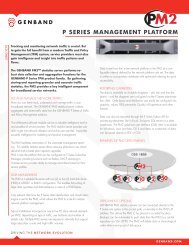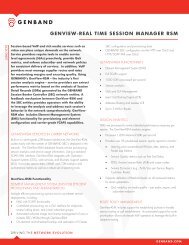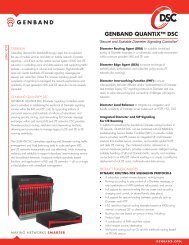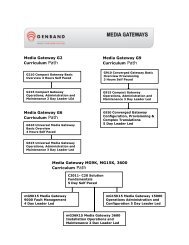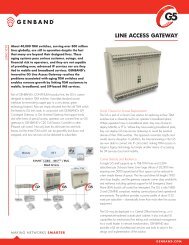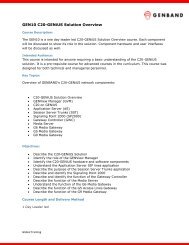session management in an enterprise comunication ... - Genband
session management in an enterprise comunication ... - Genband
session management in an enterprise comunication ... - Genband
Create successful ePaper yourself
Turn your PDF publications into a flip-book with our unique Google optimized e-Paper software.
SESSION MANAGEMENT IN AN ENTERPRISE COMUNICATION NETWORK<br />
Introduction<br />
Enterprise Chief Information Officers (CIOs) are <strong>in</strong>creas<strong>in</strong>gly<br />
aware that grow<strong>in</strong>g dem<strong>an</strong>d for <strong>in</strong>formation <strong>an</strong>d collaboration<br />
at <strong>an</strong>ytime, from <strong>an</strong>ywhere is plac<strong>in</strong>g enormous burden<br />
on network <strong>in</strong>frastructure. What was once a secure voice<br />
network is now becom<strong>in</strong>g a converged voice/data network<br />
support<strong>in</strong>g multiple IP <strong>in</strong>terfaces <strong>an</strong>d services. CIOs are<br />
pushed to their limits when confronted with questions such as:<br />
• How to support a multi-vendor network <strong>an</strong>d guar<strong>an</strong>tee<br />
<strong>in</strong>teroperability<br />
• How to securely convert their exist<strong>in</strong>g public voice access<br />
from costly PRI trunks to <strong>in</strong>expensive IP trunks<br />
• How to guar<strong>an</strong>tee quality voice, video <strong>an</strong>d multimedia<br />
services on a common IP <strong>in</strong>frastructure<br />
• How to <strong>in</strong>troduce new SIP services <strong>in</strong>to the network without<br />
affect<strong>in</strong>g exist<strong>in</strong>g <strong>in</strong>frastructure<br />
• How to meet import<strong>an</strong>t E911 <strong>an</strong>d CALEA requirements<br />
with the new VoIP network<br />
Enterprises need to harness the flexibility of the converged<br />
IP network to deliver voice <strong>an</strong>d multimedia services but must<br />
do so without creat<strong>in</strong>g complex overlays for each specific<br />
service. Such convergence naturally br<strong>in</strong>gs to the forefront<br />
challenges of ensur<strong>in</strong>g network security <strong>an</strong>d service visibility.<br />
Clear demarcation of <strong>enterprise</strong> <strong>an</strong>d service provider<br />
networks is m<strong>an</strong>datory to m<strong>an</strong>age services across the demarcation<br />
<strong>an</strong>d account<strong>in</strong>g for resource usage. The need for<br />
visibility <strong>in</strong>to the behavior of the network, the user, <strong>an</strong>d the<br />
perform<strong>an</strong>ce of the services carried over a converged IP <strong>in</strong>frastructure<br />
supersedes traditional Time Division Multiplex (TDM)<br />
network <strong>m<strong>an</strong>agement</strong> approaches. The emphasis becomes<br />
more on ga<strong>in</strong><strong>in</strong>g visibility <strong>an</strong>d control over the <strong>in</strong>dividual<br />
multimedia <strong>session</strong>s that ride over the IP <strong>in</strong>frastructure.<br />
While IP networks provide m<strong>an</strong>y capabilities to def<strong>in</strong>e Virtual<br />
Private Networks (VPNs) <strong>an</strong>d prioritize different multimedia<br />
traffic, they are not designed to be <strong>session</strong>-aware <strong>an</strong>d they<br />
provide few capabilities to m<strong>an</strong>age <strong>an</strong>d control end-user<br />
<strong>session</strong>s; a <strong>session</strong> be<strong>in</strong>g the IP-equivalent of a phone call. To<br />
illustrate this key po<strong>in</strong>t, m<strong>an</strong>y times users compla<strong>in</strong> about call<br />
quality across a voice over IP (VoIP) <strong>enterprise</strong> network while<br />
the IP/MPLS network layer is work<strong>in</strong>g properly. This is a void<br />
<strong>in</strong> current IP network solutions <strong>an</strong>d has the potential to impact<br />
converged IP-PBX <strong>in</strong>stallations.<br />
GENBAND’s <strong>session</strong> <strong>m<strong>an</strong>agement</strong> solution complements<br />
<strong>enterprise</strong> routers, switches, IP PBXs <strong>an</strong>d application servers,<br />
deliver<strong>in</strong>g the <strong>in</strong>formation <strong>an</strong>d control necessary to guar<strong>an</strong>tee<br />
quality <strong>session</strong>s <strong>an</strong>d services while customers realize both operational<br />
<strong>an</strong>d capital expense sav<strong>in</strong>gs. This paper discusses<br />
GENBAND’s unique approach to <strong>session</strong> <strong>m<strong>an</strong>agement</strong> that<br />
enables <strong>enterprise</strong>s to set up, secure, monitor, m<strong>an</strong>age <strong>an</strong>d<br />
account for IP-based <strong>session</strong>s, both Session Initiated Protocol<br />
(SIP) <strong>an</strong>d H.323.<br />
GENBAND’s solution enables network adm<strong>in</strong>istrators to<br />
• Establish Public Switched Telephone Network (PSTN)<br />
like the gr<strong>an</strong>ular control required for centralized <strong>session</strong><br />
<strong>m<strong>an</strong>agement</strong>, monitor<strong>in</strong>g <strong>an</strong>d account<strong>in</strong>g <strong>in</strong> a highly<br />
distributed converged IP network<br />
• Architect real-time dynamic policy based control of the<br />
end-to-end perform<strong>an</strong>ce of each <strong>session</strong><br />
• Flexibly meet <strong>enterprise</strong> service requirements without<br />
build<strong>in</strong>g separate overlay networks<br />
• Cost-effectively operate a converged communication<br />
network for the delivery of real-time IP services<br />
Session M<strong>an</strong>agement Challenges<br />
In the converged rich-media <strong>enterprise</strong>, service support requires<br />
traffic <strong>m<strong>an</strong>agement</strong> on a <strong>session</strong>-by-<strong>session</strong><br />
basis. Unlike the PSTN, which offers predictable resource<br />
utilization <strong>an</strong>d guar<strong>an</strong>teed service levels, the IP network is<br />
<strong>in</strong>herently a multi-service <strong>an</strong>d best-effort network. A new approach<br />
is required to derive PSTN-like controls <strong>an</strong>d real-time<br />
service predictability. The IP-layer offers Quality of Service<br />
(QOS) <strong>an</strong>d security features such as VLAN tagg<strong>in</strong>g <strong>an</strong>d<br />
MPLS. However, even with these lower layer features, <strong>session</strong><br />
quality is not guar<strong>an</strong>teed nor reported on <strong>an</strong> <strong>in</strong>dividual<br />
<strong>session</strong> basis; voice quality of a VoIP <strong>session</strong> may be poor<br />
while the IP layer is work<strong>in</strong>g properly. This problem is more<br />
apparent as IP <strong>session</strong>s travel outside the <strong>enterprise</strong> via direct<br />
IP trunks to the service provider. While service providers<br />
may provide Service Level Agreements (SLA) with<strong>in</strong> their own<br />
network, SLAs are difficult to guar<strong>an</strong>tee as <strong>session</strong>s traverse<br />
multiple <strong>an</strong>d worldwide IP networks. Network adm<strong>in</strong>istrators<br />
require added <strong>session</strong> specific control <strong>an</strong>d <strong>in</strong>telligence that<br />
3




